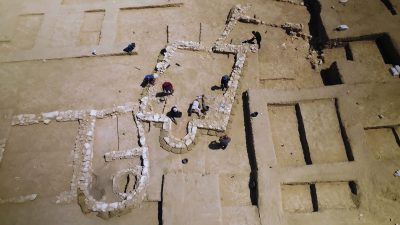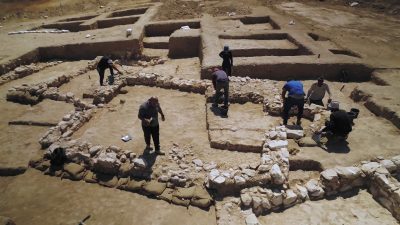×


We have detected your country as:
Please click here to go to the USA website or select another country from the dropdown list.
by: Israel Antiquities Authority
A luxurious estate and a rare rural mosque—among the earliest known worldwide (over 1,200 years old)—was recently discovered in the city of Rahat in the Negev. Large-scale archaeological excavations conducted by the Israel Antiquities Authority [IAA] to facilitate the construction of a new neighborhood in Rahat are providing graphic details of the gradual transition from Christianity to Islam that took place in the seventh to ninth centuries AD.
The excavations, directed by Dr. Elena Kogan-Zehavi, Oren Shmueli and Dr. Noe David Michael on behalf of the IAA, revealed buildings with Christian and Early Islamic characteristics in close proximity to one another.

“We uncovered a farmhouse of the Byzantine period that apparently housed Christian farmers and included a fortified tower and rooms with strong walls surrounding a courtyard. On a nearby hilltop, we found estates constructed in a completely different manner. These were built about a hundred years later, in the late seventh to ninth centuries AD—the Early Islamic period. The estate buildings, apparently built by Muslims, were constructed with lines of rooms next to large, open courtyards. Many ofthe clay-lined ovens revealed in the rooms and courtyards were probably used for cooking food.”
An early rural mosque, excavated in the vicinity in 2019, the first of its kind, provided proof of the identity of the inhabitants.
In the recent, renewed excavations, archaeologists were surprised to discover yet another rural mosque of the seventh to eighth centuries AD. The mosque includes a square room and a wall facing the direction of Mecca, the holy city of Islam. A niche shaped in a half circle is located along the center of the wall pointing southwards. These unique architectural features show that the building was used as a mosque. The mosque stands alone in the site and could have been used by several dozen Muslim worshipers for prayers.
The mosque is located south of a luxurious estate building constructed around a central courtyard. It includes halls with stone pavement, some paved with marble, and walls decorated with frescos painted in red and yellow. Remains of fine tableware and glass vessels, some decorated with drawings of plants and animals, which were revealed in the building, display the wealth of its inhabitants.

According to researchers from the IAA:
“The evidence from all of the excavation areas gathered so far—the dwellings, the houses of prayer, the ovens and utensils—sheds light on the beginnings of the historical process that took place in the northern Negev with the introduction of a new religion,—the religion of Islam—and a new rulership and culture in the region. These were gradually established, inheriting the earlier Byzantine government and Christian religion that held sway over the land for hundreds of years.”
Photo Credit: Click on photo to see credit
All logos and trademarks in this site are property of their respective owner. All other materials are property of Bridges for Peace. Copyright © 2024.
Website Site Design by J-Town Internet Services Ltd. - Based in Jerusalem and Serving the World.